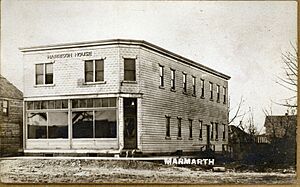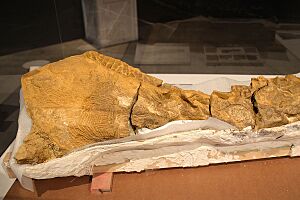Marmarth, North Dakota facts for kids
Quick facts for kids
Marmarth
|
|
|---|---|
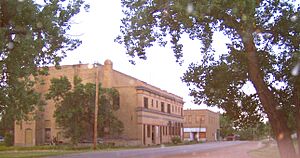
U.S. Route 12 in Marmarth, 2007.
|
|
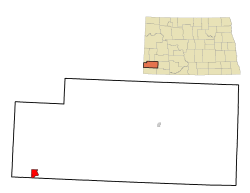
Location of Marmarth, North Dakota 58643
|
|
| Country | United States |
| State | North Dakota |
| County | Slope |
| Founded | 1907 |
| Area | |
| • Total | 2.61 sq mi (6.75 km2) |
| • Land | 2.58 sq mi (6.68 km2) |
| • Water | 0.03 sq mi (0.07 km2) |
| Elevation | 2,710 ft (826 m) |
| Population
(2020)
|
|
| • Total | 101 |
| • Estimate
(2022)
|
97 |
| • Density | 39.18/sq mi (15.13/km2) |
| Time zone | UTC-7 (Mountain (MST)) |
| • Summer (DST) | UTC-6 (MDT) |
| ZIP code |
58643
|
| Area code(s) | 701 |
| FIPS code | 38-50860 |
| GNIS feature ID | 1036151 |
Marmarth is a small city in Slope County, North Dakota, USA. In 2020, its population was 101 people. The city is located in the southwestern part of North Dakota, very close to the Montana border.
Marmarth was founded in 1907 as a railroad town. It was part of the Milwaukee Road line that stretched from Seattle to Chicago. By 1920, Marmarth was a bustling place with over 1,300 residents. However, its population has slowly decreased over the years.
The town is famous for many historical events. These include stories about the Lakota Native Americans. It's also known for amazing dinosaur discoveries, like the Dakota fossil. Former president Theodore Roosevelt visited Marmarth many times. He even shot his first buffalo and grizzly bear near the Little Missouri River here. The old ranch house where he stayed is still standing. Another interesting sight is the "Woman in Stone," a 50-foot rock that looks like a woman's face.
Marmarth is close to the Theodore Roosevelt National Park. It's also next to the Little Missouri National Grassland. The city is the closest town to Big Gumbo, a large public wilderness area.
Contents
What's in a Name?
The name "Marmarth" comes from a combination of letters. It uses parts of the first and middle names of Margaret Martha Finch. She was the granddaughter of Albert J. Earling, who was the president of the railroad at the time.
Marmarth is also called the "city of trees." This is because it's one of the few places with many trees in the Badlands region of Southern North Dakota.
Where is Marmarth?
Marmarth is located in the Badlands region of North Dakota. It sits right next to the Little Missouri River. This is where the Little Missouri River meets Hay Creek and Little Beaver Creek.
The city is about 2,709 feet (826 meters) above sea level. It's known as "the city of trees" because it's like a green island in the mostly treeless Badlands. It's also the only place in North Dakota where special pine trees called limber pines grow.
Marmarth covers an area of about 2.52 square miles (6.53 square kilometers). Most of this area is land, with a small part being water.
Marmarth's Weather
Marmarth has a semi-arid climate. This means it's usually dry, but not a desert. It gets some rain, but not a lot.
Marmarth's Past
Native American History
The area around Marmarth was originally home to the Lakota and Crow people tribes. Some historians believe these tribes might have been part of the ancient Mound Builders civilization.
In 1864, a group of 200 gold-seekers was traveling near what is now Marmarth. They were attacked by over a hundred Hunkpapa Sioux warriors. These warriors were led by the famous chief Sitting Bull. During the battle, Sitting Bull was injured. Six Hunkpapa warriors, ten soldiers, and two civilians died. The place where this battle happened, called the Site of Fort Dilts, is now a historic landmark.
Theodore Roosevelt's Visits
Theodore Roosevelt visited Marmarth many times. It's said that he shot his first grizzly bear and his first buffalo here. He hunted by the Little Missouri River. The old ranch house on Hay Creek where he stayed is still standing today.
Becoming a Town
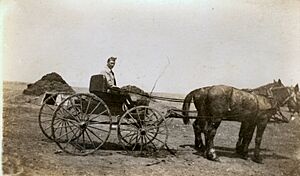
Marmarth became a very popular place for homesteading in the late 1800s and early 1900s. Homesteading meant people could get free land if they lived on it and farmed it. The town was founded in 1907 because of the new Milwaukee Road train line. This line connected the country from coast to coast. Cheap land and good farming also attracted people.
The town was first planned on the east side of the Little Missouri River. But there were problems getting enough land there. So, in 1908, the city was moved to the other side of the river. Many pioneers came here, especially after the Dust Bowl in search of a new life.
Marmarth grew quickly to serve the many homesteaders. The first twenty years of the 1900s were very wet, which was great for farming. Farmers had huge wheat harvests, making them hopeful for wealth. By 1920, Marmarth had 1,318 people. It had an auditorium, a theater, a big train station, a newspaper, and even paved sidewalks.
One story from April 1920 tells of rancher Jack Miller. He had to escape a flood on Beaver Creek on horseback. His horse slipped, and Miller, who had only one arm, ended up in the icy water. He managed to climb onto an iceberg and danced all night to stay warm. In the morning, he found safety at a neighbor's house.
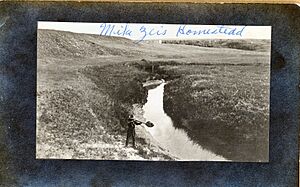
Marmarth was the largest town on the Milwaukee railroad line in North Dakota by 1911. It was also the fifth largest town west of the Missouri River. Michael Zeis, an early settler, described the town. He said he had a cigar shop and sold cigars in nearby towns. He worked for the railroad from 1908 to 1918.
The town had its own doctor, Dr. Frederick A. Bordwell. It also had an Opera House, a Barber Building, and the Mystic Theatre which opened in 1914. There was a car dealership and a hardware store. The town was even known to have jailed members of the famous Jesse James’ gang.
By the 1920s, things changed. World War I ended, and the weather became drier. Many settlers left their farms. By 1930, Marmarth's population had dropped by almost half. This decline has continued ever since.
Dinosaur Discoveries
Marmarth is a great place for finding dinosaur fossils! Many dinosaur bones have been discovered here, including the famous Dakota fossil.
The Marmarth Historical Society and the Marmarth Research Foundation offer summer classes. You can learn about digging up fossils where Triceratops and duckbill dinosaurs have been found. These courses teach you how to prepare fossils and how to find them in the field.
The Dakota fossil is a fossilized Edmontosaurus, a type of duckbill dinosaur. It was found near Marmarth in 1999 by Tyler Lyson. What makes this fossil special is that not just the bones were preserved. Even soft tissues like skin and muscle were fossilized!
Marmarth's Population
Marmarth's population has changed a lot over the years.
- 1910: 790 people
- 1920: 1,318 people (the highest it ever was!)
- 1930: 721 people
- 1940: 626 people
- 1950: 469 people
- 1960: 319 people
- 1970: 247 people
- 1980: 190 people
- 1990: 144 people
- 2000: 140 people
- 2010: 136 people
- 2020: 101 people
As of 2010, there were 136 people living in Marmarth. Most residents were White (89.7%), and some were Native American (9.6%). About 8.1% of the population was Hispanic or Latino. The average age in Marmarth was 41 years old.
Local Wildlife
The area around Marmarth is full of amazing wildlife. You can find many different animals here, especially in the southern part of Theodore Roosevelt National Park.
Some of the animals you might see include:
- Pronghorn antelope
- Black-tailed prairie dog
- Feral horse
- Bison
- Bighorn sheep
- Elk
- White-tailed deer
- Mule deer
- Wild turkey
- Bull snake
- Prairie rattlesnake
Many types of birds also live here, such as:
- Ferruginous hawk
- Golden eagle
- Greater sage-grouse
- Mountain bluebird
- Brewer's sparrow
- Burrowing owl
- Lark bunting
- Chestnut-collared longspur
- Long-billed curlew
- Red-tailed hawk
- Common poorwill
- Chickadee
- Spotted towhee
- Lazuli bunting
- Clark's nutcracker
Cool Places to Visit
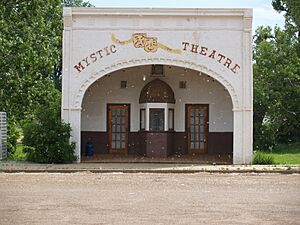
If you visit Marmarth, here are some interesting places to check out:
- Theodore Roosevelt National Park: A beautiful national park with amazing landscapes and wildlife.
- Mystic Theatre: A historic theater built in 1914. It's listed on the National Register of Historic Places.
- Marmarth Research Foundation: This group offers chances to join local dinosaur digs and learn about fossils.
- Theodore Roosevelt's old ranch house: The house by Hay Creek where President Roosevelt stayed.
- Fort Dilts: A historic site where a battle took place involving Sitting Bull. It's also on the National Register of Historic Places.
- Big Gumbo: A huge public wilderness area perfect for exploring nature.
- Little Missouri National Grassland: A large area of grasslands with diverse wildlife.
- Marmarth Historical Society: Learn more about the town's rich history here.
- The Woman in Stone statue: A unique rock formation that looks like a woman's face.
Famous People from Marmarth
- Tyler Lyson: A paleontologist who discovered the famous Dakota fossil near Marmarth.
See also
 In Spanish: Marmarth (Dakota del Norte) para niños
In Spanish: Marmarth (Dakota del Norte) para niños


